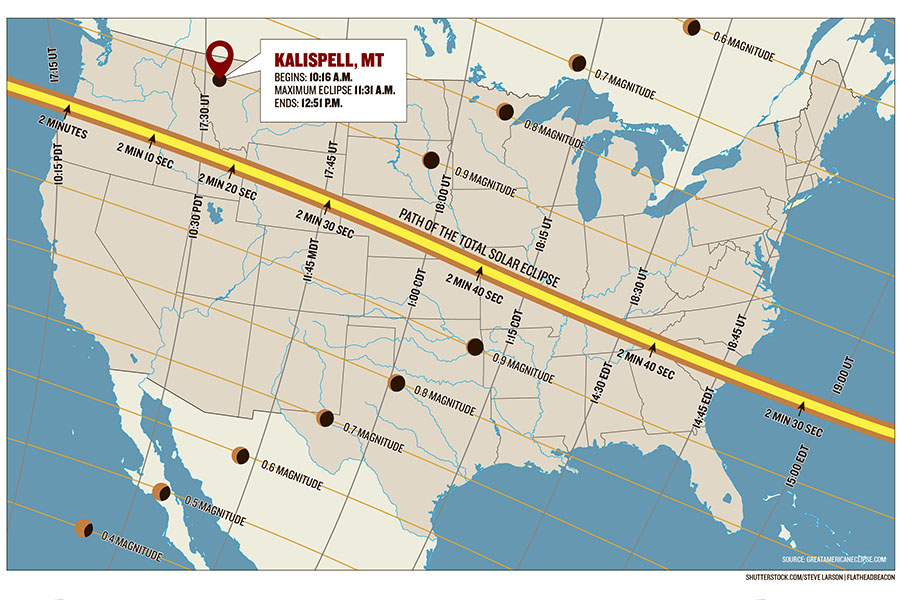For the first time in a quarter century, a total eclipse will be seen from the United States. NASA estimates that 500 million people will be able to see the total or partial eclipse on Aug. 21, in what has been dubbed “The Great American Eclipse.”
Here in Northwest Montana, we’ll be treated to a partial eclipse that day where the moon will block out most of the sun for about 30 minutes. Further south, the moon will block out the entire sun in what is called the “path of totality.” Millions of people are expected to converge on this narrow band of land — about 70 miles wide — stretching from Lincoln Beach, Oregon, to Charleston, South Carolina. Within the path of totality, the moon will block the sun for more than two minutes.
Regardless of where you stop to look to the sky, astronomers say it will be an unforgettable show.
What is an eclipse and what will I see?
An eclipse occurs when the moon blocks out part of the sun in the middle of the day. In Kalispell, the moon will start to obscure the sun shortly after 10:15 a.m. and continue until about 12:45 p.m. At 11:31 a.m., the moon will cover 87 percent of the sun, turning daylight into darkness.
“It is going to be noticeably dark outside around here,” said Russ Lucas, an amateur astronomer and volunteer for Glacier National Park’s night sky program.
Safety
While the solar eclipse is a sight to behold, it’s important to view it safely, according to NASA. Here are some tips for enjoying the show.
• Only use special-purpose solar filters, also known as “eclipse glasses,” to look at the eclipse. The only place you can view it without glasses is in the path of totality during the two minutes when the sun is completely blocked by the moon.
• Always supervise children using eclipse glasses.
• Never use regular sunglasses to view the solar eclipse.
• Always cover your eyes with eclipse glasses before looking up at the sun. Do not remove the glasses until you have looked away.
• Do not look at the sun through a camera, a telescope, binoculars, or any other optical device while using your eclipse glasses because the concentrated solar rays can damage the filter and your eyes.
Where can I see it?
The great thing about the solar eclipse is that you can take in the show just about anywhere. But there will also be a number of viewing parties in Northwest Montana on Aug. 21. Flathead Valley Community College is hosting a public viewing on its campus lawn starting at 10:30 a.m. The North Lake County Public Library in Polson is hosting a solar eclipse block party from 10 a.m. to 1 p.m. The Northwest Montana Chapter of the Forest Fire Lookout Association and the Bob Marshall Wilderness Foundation are hosting a viewing party at the Firefighter Mountain Lookout near Hungry Horse. Reservations are required, and organizers are asking for a $50 donation. Call (406) 387-3822 for more information. Glacier Guides and Montana Raft is hosting a viewing party on the Middle Fork Flathead River. Call (406) 387-5555 for more information. Whitefish Mountain Resort is also hosting a viewing party at the summit. Visit skiwhitefish.com for more information.
Citizen science
While many people are looking forward to the solar eclipse, few are as excited as Lucas, a local amateur astronomer. The Columbia Falls man has been interested in astronomy his entire life and is a volunteer for Glacier National Park’s astronomy program. Lucas is going to be in Stanley, Idaho on Aug. 21 helping gather data from the Citizen Cate Experiment run by the National Solar Observatory. The citizen scientist will be one of 68 people across the country operating a specialized telescope to gather images during the two minutes of totality. The images will be used to study the sun’s corona, the outermost part of the star’s atmosphere. Immediately after the eclipse, Lucas and others like him will upload images online that will be used to make a brief movie about the event.
“It is an absolute honor to be a part of this,” he said. “This is the highlight of my life as an amateur astronomer.”
